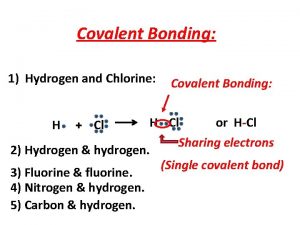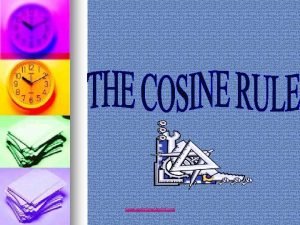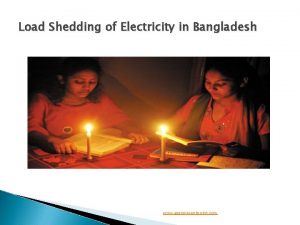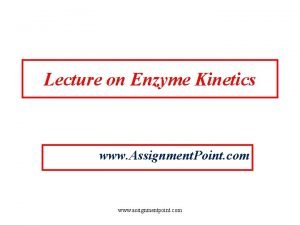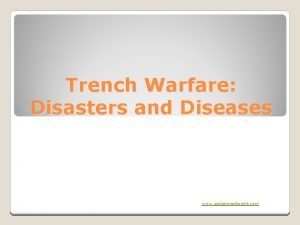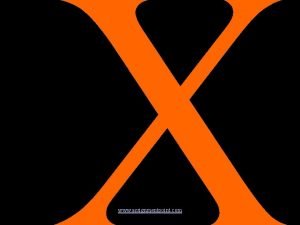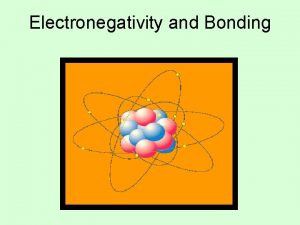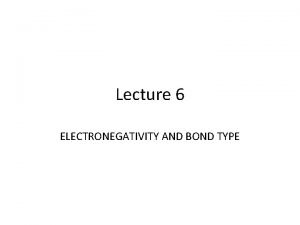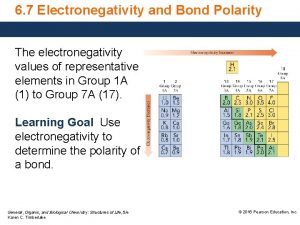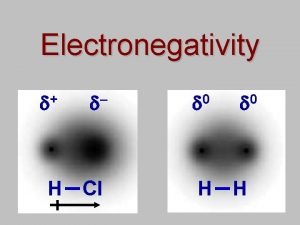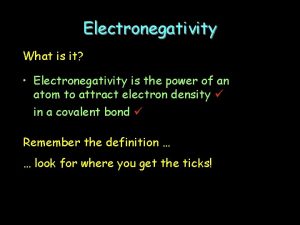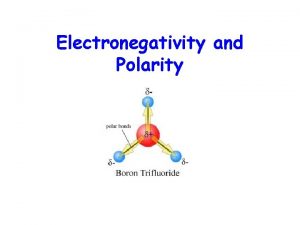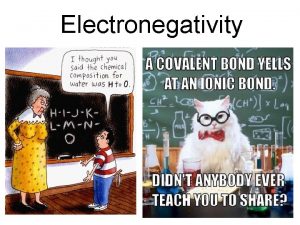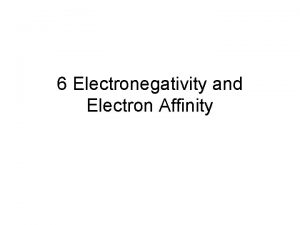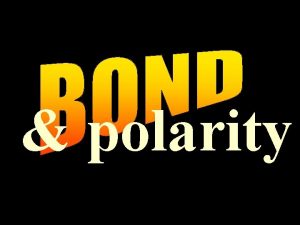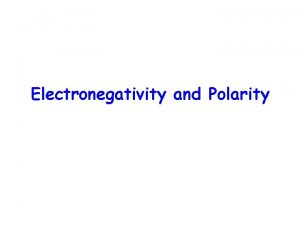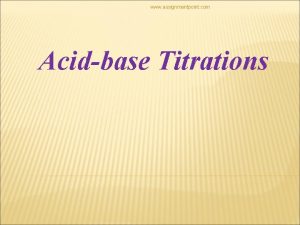Electronegativity www assignmentpoint com Electronegativity The type of




















- Slides: 20

Electronegativity www. assignmentpoint. com

Electronegativity The type of bond formed between a pair of atoms is determined by the ability of the atoms to attract electrons from the other. A positively charged ion (CATION) is formed when an atom looses one or more electrons and a negatively charged ion (ANION) is formed when an atom accepts one or more electrons. For a free, isolated atom its ability to loose an electron is measured by its IONIZATION ENERGY, while the ability to gain an electron is measured by its ELECTRON AFFINITY www. assignmentpoint. com

The average of these two properties for isolated atoms define the atom’s ELECTRONEGATIVITY which measures the tendency of one atom to attract electrons from another atom to which it is bonded. For example, Metallic elements loose electrons (to form positive ions) more readily than non-metallic elements Metallic elements are hence referred to as being more ELECTROPOSITIVE that non-metals. Non-metals are more ELECTRONEGATIVE compared to metals www. assignmentpoint. com

The periodic table’s arrangement results in a separation of metals from non-metals (metallic nature increasing to the left and down, non metallic increasing right and up). This allows for a comparative scale for the electronegativity of elements. www. assignmentpoint. com TABLE

Electronegativity Scale Fluorine is the most electronegative element, and francium the least electronegative. www. assignmentpoint. com TABLE

Large differences in electronegativity between two bonded atoms favor the transfer of electrons from the less electronegative (more electropositive) atom to the more electronegative atom resulting in a bond between the two atoms that is IONIC. Smaller differences result in a more equitable “sharing” of electrons between the bonded atoms, resulting in a COVALENT bond between the two atoms. The kinds of bonds formed between elements (covalent vs ionic) can be determined by comparing electronegativity of the two elements. www. assignmentpoint. com TABLE

Na and Cl form ionic bonds. Na gives up an electron and Cl accepts the electron to form Na+ and Cl-. As differences between electronegativity between the two bonding elements decreases, there is more equitable www. assignmentpoint. com sharing of electrons and the elements form covalent bonds.

Based on the position of elements in the periodic table, we can determine the kind of bond formed Generally: Nonmetallic element + nonmetallic element Molecular compounds are typically gases, liquids, or low melting point solids and are characteristically poor conductors. Examples are H 2 O, CH 4, NH 3. www. assignmentpoint. com TABLE

Generally, Metallic compound + nonmetallic compound IONIC compound Ionic compounds are generally high-melting solids that are good conductors of heat and electricity in the molten state. Examples are Na. Cl, common salt, and Na. F, sodium fluoride. www. assignmentpoint. com TABLE

NAMING COMPOUNDS The chemical formula represents the composition of each molecule. In writing the chemical formula, in almost all cases the element farthest to the left of the periodic table is written first. So for example the chemical formula of a compound that contains one sulfur atom and six fluorine atoms is SF 6. If the two elements are in the same period, the symbol of the element of that is lower in the group (i. e. heavier) is written first e. g. IF 3. www. assignmentpoint. com

In naming covalent compounds, the name of the first element in the formula is unchanged. The suffix “-ide” is added to the second element. Often a prefix to the name of the second element indicates the number of the element in the compound SF 6 – sulfur hexafluoride P 4 O 10 – tetraphosphorous decoxide CO – carbon monoxide CO 2 – carbon dioxide www. assignmentpoint. com

The binary compounds of hydrogen are special cases. They were discovered before a convention was adopted and hence their original names have stayed Water H 2 O is not called dihydrogen monoxide Hydrogen forms binary compounds with almost all nonmetals except the noble gases. Example HF - hydrogen fluoride HCl - hydrogen chloride H 2 S - hydrogen sulfide www. assignmentpoint. com

Organic molecules (containing C) have a separate nomenclature The molecular formulas for compounds containing C and H (called hydrocarbons) are written with C first. Example, CH 4, C 2 H 6, etc. www. assignmentpoint. com

BINARY IONIC COMPOUNDS Compounds formed by elements on opposite sides of the periodic table which either give up (left side) or take up electrons (right side). Depending on the atom, there can be an exchange of more than one electron resulting in charges greater than ± 1. www. assignmentpoint. com

Group IA – alkali metals – loose 1 e- to form +1 (Na+) Group II A– alkaline earth metals –loose 2 e- to form +2 (Ca+2) Group III A– loose three e- to form +3 (Al+3) Group IV A– loose four e- to form +4 (Sn+4) Group V A– accept three e- to form – 3 (N-3) Group VI A– accept two e- to form – 2 (O-2) Group VIIA – accept onewww. assignmentpoint. com e- to form – 1 (Cl-1)

Naming IONIC compounds Anions – suffix – “ide” So Cl- is chloride Oxygen O 2 - is OXIDE S 2 - is SULFIDE Cations For Na+, Ca 2+, the name of the ion is the same except refer to the ion. So SODIUM ION or SODIUM CATION Na. Cl - sodium chloride Ca. Cl 2 - calcium chloride www. assignmentpoint. com

Covalent, charged compounds - MOLECULAR IONS Positive Molecular Ions End the name with “ium” or “onium” NH 4+ is ammonium, H 3 O + is hydronium Negative Molecular Ions - NO 3 - NITRATE 2 - SO 4 - SULFATE - NO 2 - NITRITE 3 - PO 4 - PHOSPHATE www. assignmentpoint. com

Transition Elements The transition elements are chemically quite different from the metals in the “A” block, due to differences in electronic configuration For example, Fe can loose two or three electrons to become www. assignmentpoint. com Fe 2+ and Fe 3+, respectively.

To identify the charge of Fe in a compound the following nomenclature is used. Fe 2+ is iron(II) Fe 3+ is iron (III) So iron(III) chloride is Fe. Cl 3 An older scheme differentiated between the lower and higher charge by ending the name of the element with “ous” to indicate the lower charge and “ic” for the higher. ferrous chloride => Fe. Cl 2 ferric chloride => Fe. Cl 3 However, this convention does not indicate the numerical value of the charge. www. assignmentpoint. com

This powerpoint was kindly donated to www. worldofteaching. com http: //www. worldofteaching. com is home to over a thousand powerpoints submitted by teachers. This is a completely free site and requires no registration. Please visit and I hope it will help in your teaching. www. assignmentpoint. com
 Cơm
Cơm Dậy thổi cơm mua thịt cá
Dậy thổi cơm mua thịt cá Chlorine covalent bond
Chlorine covalent bond Assignmentpoint.com
Assignmentpoint.com Assignmentpoint.com
Assignmentpoint.com Assignmentpoint.com bangladesh
Assignmentpoint.com bangladesh Mail @ assignmentpoint.com
Mail @ assignmentpoint.com Www.assignmentpoint.com
Www.assignmentpoint.com Assignmentpoint.com
Assignmentpoint.com Www assignment
Www assignment Assignment point
Assignment point Assignmentpoint.com
Assignmentpoint.com Importance of forestry
Importance of forestry Mail @ assignmentpoint.com
Mail @ assignmentpoint.com Assignment point.com
Assignment point.com Glibbering
Glibbering Assignmentpoint
Assignmentpoint Basiospore
Basiospore Sequence diagram exercise
Sequence diagram exercise Assignmentpoint.com
Assignmentpoint.com Www.assignmentpoint.com
Www.assignmentpoint.com


